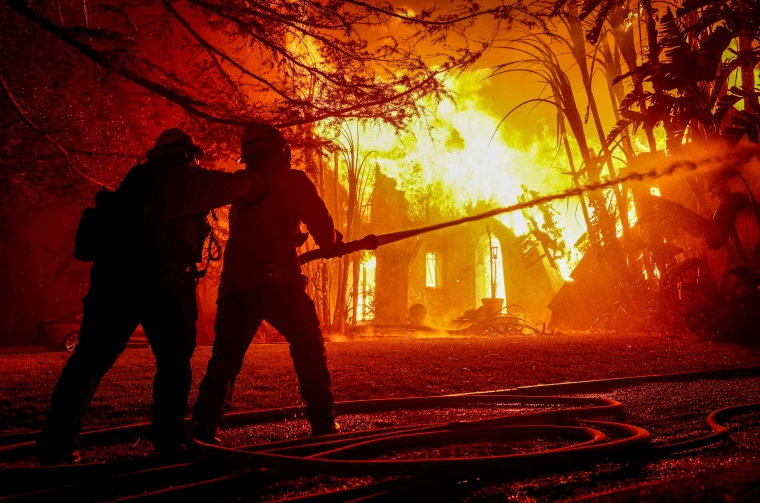Introduction
The recent wildfires in Los Angeles County, described as the most devastating fire seasons in recent history, have brought to light significant issues regarding property insurance coverage and the complexities of filing claims after natural disasters.
In a 2023, a similar devastating fire hit L.A. and as the fires wreaked havoc on thousands of homes and businesses, property owners faced not only the devastating loss of their homes but also significant hurdles when navigating insurance claims.
This case study explores the legal implications for property insurance, the challenges policyholders face when filing claims, and the role of insurance companies in the wake of the recent (2025) L.A. Wildfires.
Background of the Event
In 2023, a series of wildfires ravaged Los Angeles County, leaving behind extensive damage in areas such as Malibu, Calabasas, and other parts of the San Fernando Valley. According to the California Department of Forestry and Fire Protection (CAL FIRE), nearly 30,000 acres were scorched, and over 2,000 homes were destroyed. These fires were among the largest and most destructive in California’s history, exacerbating the state’s already challenging situation with wildfire risk.
As residents began to assess the damage to their properties, insurance claims poured in, with many policyholders hoping to rebuild their homes and businesses. However, the aftermath revealed a series of challenges related to the adequacy of insurance coverage, delays in claim processing, and disputes over the terms and conditions of insurance policies.
Legal Issues Surrounding Property Insurance After Wildfires
- Underinsurance and Coverage Gaps
One of the most significant issues that arose in the wake of the L.A. Wildfires was the underinsurance of many properties. Many homeowners were found to have insurance policies that did not adequately cover the full replacement value of their properties. California law requires homeowners to have enough coverage to rebuild their homes if they are destroyed by a wildfire, but many residents had policies that covered only a fraction of their actual rebuilding costs. As construction prices soared due to the high demand for rebuilding efforts in the fire’s aftermath, policyholders were left with insufficient coverage to repair or replace their homes.
Additionally, some policies did not include coverage for specific types of damage caused by wildfires, such as damage from smoke or ash. Homeowners found themselves unable to file claims for certain losses or were forced to settle for much lower compensation than they needed.
- Delayed Claims and the Role of Adjusters
Another legal issue that arose was the delay in processing insurance claims. Insurance companies, faced with a surge of claims in a short period, often took several months to assess damage and approve claims. During this time, many homeowners were left without adequate housing or financial support, further exacerbating the emotional and financial toll of the disaster.
Additionally, the appointment of insurance adjusters to assess property damage also became a point of contention. Some policyholders felt that adjusters underappreciated the severity of the damage, leading to lower settlement offers than were warranted. There were reports of insurance companies requiring multiple assessments before agreeing on the final compensation amount, further delaying the process.
- Exclusions and Limitations in Wildfire Coverage
Insurance policies also contain exclusions and limitations that became problematic in the wake of the L.A. Wildfires. For example, some insurance companies refused to cover properties that were located in high-risk wildfire zones, even if the policyholders had paid premiums for years. In other instances, policies included clauses that limited the payout for fire damage in certain areas, leaving policyholders under-compensated for their losses.
Additionally, many homeowners did not realize that their policies had certain caps on how much could be paid out for specific losses, such as personal property or structural damage. This lack of transparency led to confusion and disputes between policyholders and insurers about what was covered under their policies.
- Bad Faith Insurance Practices
In many cases, property owners alleged that insurance companies engaged in bad faith practices by denying claims, offering settlements far below the actual value of the losses, or unreasonably delaying claim processing. California law mandates that insurance companies act in good faith and deal fairly with policyholders. However, there were numerous reports of companies failing to meet these standards, particularly in high-stress situations like the L.A. Wildfires.
Policyholders facing these challenges sought legal recourse through lawsuits alleging bad faith insurance practices. These lawsuits argued that insurers had not acted in the best interests of the policyholders, violated the terms of the insurance contracts, or failed to meet statutory obligations.
Case Example: The Turner Family’s Claim
The Turner family’s experience exemplifies the broader challenges faced by many property owners after the L.A. Wildfires. The Turners, residents of Malibu, lost their home and all personal property to the fire. While they had an insurance policy that they believed would fully cover the loss, they were devastated to learn that the policy had a clause that excluded certain fire-related damages in high-risk zones like Malibu.
The Turners filed a claim immediately after the fire, expecting their insurance company to cover the full rebuilding costs. However, after several months of delays and multiple assessments, the insurance company offered only a fraction of the amount needed to rebuild their home. The company cited the exclusion clause in the policy, arguing that the property was in a high-risk zone. Furthermore, the company failed to provide clear explanations of how the settlement amount was determined.
The Turners filed a lawsuit against the insurance company, alleging bad faith practices. Their case focused on the failure of the insurer to provide clear communication regarding the exclusion clauses in the policy and the company’s failure to act promptly in processing the claim. Ultimately, the Turners were awarded a settlement that covered the rebuilding costs, but only after an extended legal battle.
Implications for Insurance Law and Policyholders
The legal challenges faced by policyholders in the aftermath of the L.A. Wildfires underscore the need for reform in property insurance practices, particularly in wildfire-prone areas. Legal experts suggest that policyholders should carefully review their policies to ensure they have adequate coverage for wildfire damage, including provisions for full replacement cost coverage and specific clauses related to wildfires.
For insurers, the case highlights the importance of transparency in policy language and the need for timely and fair claim processing. Insurance companies are encouraged to improve communication with policyholders and expedite the claims process to avoid legal disputes.
Moreover, there is a growing demand for regulatory reforms to protect homeowners from potential exploitation by insurers in the aftermath of natural disasters. California has introduced legislative proposals aimed at strengthening consumer protections and enhancing the accountability of insurance companies when dealing with wildfire claims.
Conclusion
The legal challenges arising from property insurance claims in the aftermath of the 2023 L.A. Wildfires highlight the complexities of the insurance industry in the face of natural disasters. As wildfires continue to threaten communities in California and beyond, it is essential for both policyholders and insurers to understand the terms of property insurance policies, the legal protections available to consumers, and the potential for bad faith insurance practices. In the coming years, it is likely that both legal reform and increased consumer advocacy will play pivotal roles in ensuring that property owners receive the fair compensation they are entitled to after devastating natural disasters.

